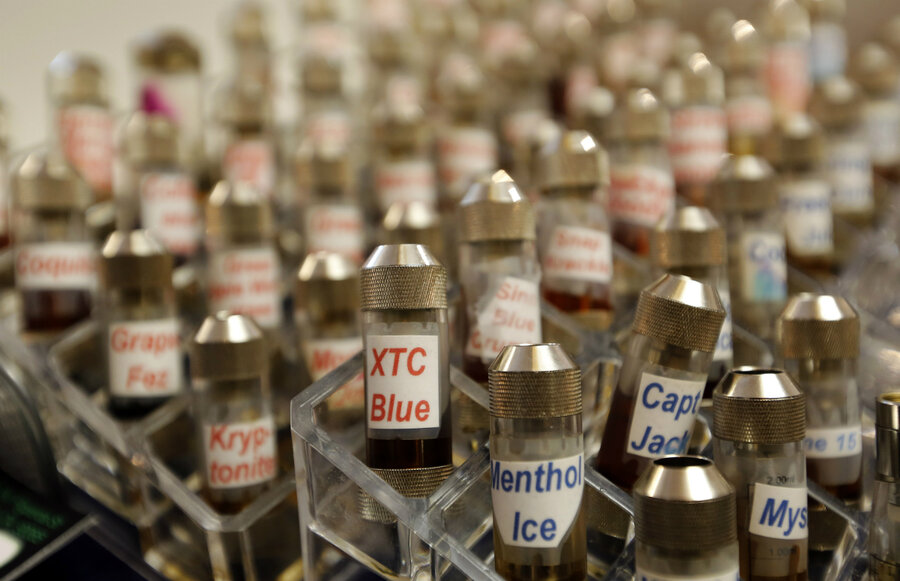US starts to nip vaping in the bud
Loading...
A growing number of US cities and states have begun to enforce bans on e-cigarettes in public areas, often citing the startling popularity of vaping among young people and its possible negative effects on bystanders.
There has been a recent uptick in states including e-cigarettes in already existing smoke-free laws. Of the 11 states that have passed comprehensive smoke-free indoor air laws, six implemented them within the past three years.
New York is the 11th and most recent state to institute a statewide ban on vaping in public spaces. (Washington, D.C., and Puerto Rico also have similar laws.)
New York precludes vaping anywhere that smoking is banned with its inclusion of e-cigarettes in smoke-free laws. “This measure closes another dangerous loophole in the law, creating a stronger, healthier New York for all,” said New York Gov. Andrew Cuomo in a statement.
Cigarette smoking in the United States has been in decline over the past decade, dropping to its lowest rate in 2015, according to the Centers for Disease Control and Prevention (CDC). But the introduction of e-cigarettes containing nicotine has experts concerned that a new generation will get hooked on smoking. While it is too early to determine a definite cause, some say they are hopeful that a significant one-year decline in teen vaping may indicate that the new efforts are taking hold.
After e-cigarettes were introduced to the US market in 2007 they surged in popularity among youths. By 2015, approximately 1 in 6 high school students said they were using e-cigarettes, according to the US Surgeon General. Easy access, low cost, a wide assortment of friendly-sounding flavors such as bubble gum and cotton candy, and aggressive advertising campaigns by manufacturers added to the product’s appeal to youths, says Brian King, deputy director for research translation at the CDC’s Office on Smoking and Health.
Experts are particularly concerned that vaping will lead to cigarette smoking. Dr. King points to more than a dozen studies that show a strong association between e-cigarettes and cigarette smoking, both of which contain nicotine. The studies conclude that children who use e-cigarettes are more likely to try conventional cigarettes later on in life, King says.
One difficulty in combating the popularity of e-cigarettes among youths has been a lack of understanding about their harmful effects.
“There is a perception that e-cigarettes are safer than combustible cigarettes, which they may be...,” says Jennifer Unger, professor of preventive medicine at the University of Southern California. “[B]ut some people think they’re completely safe, and they’re definitely not completely safe.”
The CDC warns that the presence of addictive nicotine in e-cigarettes is a cause for concern for pregnant women, those who have never tried tobacco before, and especially young people whose brains are still developing. Even the aerosol emitted from e-cigarettes can present a danger to nonsmoking bystanders. The aerosol has been characterized as “not harmless” by the Surgeon General since it contains “harmful and potentially harmful chemicals.”
In addition to state smoke-free laws, the Food and Drug Administration has begun to regulate the e-cigarette market. Since 2016, e-cigarette manufacturers have been required to put nicotine warning labels on e-cigarettes and seek FDA marketing approval for their products. The FDA has also banned the sale of e-cigarettes to anyone under the age of 18.
Regulations and bans are some of the tactics used to help lower the number of cigarette smokers in the US. (The CDC notes that e-cigarettes may help current cigarette smokers to quit altogether.)
“We do know that, based on past science with conventional cigarettes, when you prohibit their use in public areas, that helps to de-normalize the use of those products in that environment...,” says King. “[I]t’s no longer seen as a normal behavior.”
A downturn in the number of youths using e-cigarettes in the past year gives experts hope that recent public education efforts and the prohibition of vaping in public may have a lasting effect. Youth use of e-cigarettes dropped 5 percent in one year, with only 1 in 10 high-schoolers using e-cigarettes in 2016, according to King.
“[I]t’s really just a matter of extending and modernizing those proven interventions [for cigarette smoking and] including e-cigarettes in smoke-free policies,” he says.








